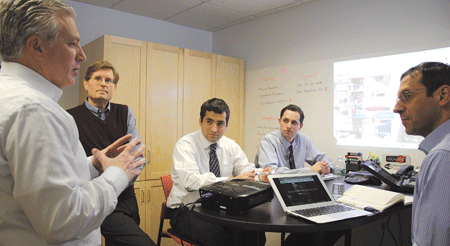A Real Kick Start
WNEU Students Tackle Crowd-funding Project for Russian Robotics Firm

From left, John Garvey, Harlan Spotts, Mark Manolakis, Matt O’Connor, and Dan Koval discuss online marketing.
“I work pro bono as a mentor with an organization called MassChallenge,” said Garvey, president of marketing agency Garvey Communication Associates, referring to the Boston-based startup accelerator program. “They contacted me and asked if I’d be interested in working with a variety of Russian startups.”
The one that interested him was a company called xTurion, led by CEO Sergey Kolyubin, which had developed an intriguing, multi-faceted home-security system that roves around the house like a Roomba.
“They were looking for digital marketing help,” Garvey said, and that brought to mind two people: Dan Koval, a Great Barrington-based marketer and inventor, who has some experience with online fund-raising campaigns through the crowd-funding site Kickstarter, and Harlan Spotts, a professor of Marketing in the College of Business at Western New England University, who is always looking for educational, real-world projects for his students.
“Harlan is a long-time friend of mine,” Garvey said, “so I thought it would be a neat project to get him together with the Russian startup to work on a Kickstarter campaign.”
Spotts and two students in a class called Marketing Seminar — Mark Manolakis and Matt O’Connor — recently met with Koval to pick his brain on developing such a campaign, and the pitch is expected to go live in April.But back up a moment — what, exactly, is Kickstarter? And why is crowd funding the latest buzzword in digital marketing and fund-raising?
“In the past, entrepreneurs with ideas for businesses relied on venture capital or raised seed funding from friends and family,” writes Amanda Barbara in Forbes. “Crowd funding offers an advantage traditional methods don’t by providing validation as well as money. A successful campaign shows that there’s a market for what you offer. Getting additional funding is easier once an idea is proven viable.”
Crowd-funding sites like Kickstarter, Indiegogo, and other, smaller entities essentially generate funds from the public to complete projects, from books, music, and movies to high-tech gadgets. Kickstarter is especially strong with cutting-edge inventions, Barbara notes. In return for their support, donors are offered rewards depending on their level of giving. The catch? The beneficiary sets a monetary goal and a time deadline; if the goal isn’t reached, no money is collected.
Kickstarter alone boasts that 8 million people have visited the site to back a project, while 284,000 people have backed 10 or more enterprises. In other words, crowd funding has reached the big time in the world of startups.
“In years past, crowd funding as a means of financing a business was a novelty, a rare exception to the traditional methods of bank loans, venture capital, and borrowing money,” writes Nicole Fallon, assistant editor of Business News Daily. “Today, announcing your crowd-funding campaign is just as common as any of these other options, if not more so.”
Spotts and his students, as well as the innovators at xTurion, hope to ride that wave to a successful campaign — and perhaps the next big thing in home security.
Keeping Watch
The xTurion robot features multiple sensors to detect flames and smoke, burglars, water leakages, and environmental factors, like the home’s temperature, humidity, and air quality. Homeowners can access the data — and camera images — remotely through their smartphones, which also helps separate genuine threats from false alarms.
“It’s a global home security system, and they chose us to market it,” Manolakism said. “It’s shaped like a dome, moves around the house, and is linked to your cell phone.”
He added that it’s a more effective system than the iCam Pro, another Kickstarter-aided home-security product, because it can move from room to room along a pre-programmed route.
“It’s a little robot that lives around the house; it’s basically a home-security system all in one,” O’Connor added. “It has tons of features — fire monitors, temperature sensors, all the environmental controls. And it runs all on wi-fi; you can have up to five users logged into it at once, with an app that goes with it. If it detects something, it calls you, then keeps calling down the line to whoever is logged in.
“And we’re marketing it,” he added. “Specifically, we have to figure out the best way to do a Kickstarter campaign. We just have to make sure the campaign is up and running by mid-April.”
The team is considering a goal of $150,000, which would allow xTurion to manufacture and start selling the product — hopefully by the end of 2015 — and generating enough profit to become self-sustaining, which is, of course, the goal of any crowd-funding campaign.
Koval was impressed. “The home-security industry is looking for new technology,” he said. Not that he’s a stranger to marketing intriguing products online.
“I always wanted to start a business,” said Koval, who studied marketing at UMass. But an opportunity with General Electric — which eventually saw him stationed in London and other European locales — proved irresistible, and he put his business dreams on hold for awhile. “Finally I quit and went to business school. That’s when you realize how little you really know about business.”
After his first Internet business “bombed,” Koval had an odd product idea around 2002 — a cuckoo clock with a cow replacing the bird. Convinced the MooCoo clock could be a hit, he set about finding someone to manufacture the product and then sold it through online retail channels. “It took off like crazy,” he said, and eventually expanded to other animals. “I didn’t get rich, but I bought a house and made a nice living. I sold maybe a little less than a million of those.”
From the giftware business, he moved on to something more serious. A chance conversation with a hotel-room attendant educated him about the risk of back, neck, and carpal-tunnel injuries associated with that job. “Considering how many occupational injuries there are, and how much it costs hotels to lose these people, and the cost to the workers themselves in quality of life, there was a huge incentive here for companies to reduce these injuries.”
Eventually, he developed the Duop mop, which uses a telescopic handle and a ball-and-socket mechanism to allow users to clean from ceiling to floor without too much bending and straining.
“We found that a lot of room attendants don’t use any mops; they just get down on the floor, on their hands and knees, and clean the floor,” he said, noting that the Duop eliminates the need to put that kind of strain on the body.
“So I’m in the mop business now,” he laughed, although he’s also staying active on Kickstarter by helping a friend launch a campaign for crafty housewares, in particular a candle in the shape of a cat; as the wax melts, it gradually reveals a metallic cat skeleton. “At first, I thought, ‘that’s ridiculous. Who would want something like that?’”
But the designer won him over. “We chose Kickstarter because they do a lot of design projects. I felt like the Kickstarter audience was most aligned to burning cats.”
Catch All
That’s the world of crowd funding — it’s a welcoming environment for a wide variety of products and artistic creations, and it’s hard to tell which ideas will, well, catch fire.
Among his initial advice to Spotts, Koval suggested hiring a professional videographer to shoot video of the device in action, and also to create a fund-raising goal that will get the product off the ground, but not much else. “You don’t want too much slack in there at all; you don’t try to get rich off Kickstarter.”
Rather, he noted, it’s a place to get started — a goal that applies equally to home-security robots, cat candles, or next-generation mops. n
Joseph Bednar can be reached at [email protected]






